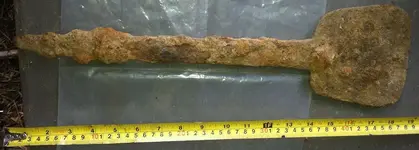I understand the stated reason for why the object cannot be cleaned at the present time. That being said, the rust-concretion on it makes accurate measuring of its various original widths/thicknesses very difficult. Those measurements are important for deducing the object's purpose. I'll have to use my imagination to remove the rust-concretion and estimate the various widths and thicknesses.
Minus the rust-concretion, the handle seems to be a little more than 1"-wide where it joins the blade, and slowly tapers to 1/2"-wide at its end. It appears to be a little under 1/2"-thick at the blade-junction, and slowly tapers down to 1/4"-thich at the other end. This suggests that the object originally had a sleeve-like wooden covering on the last several (5 or 6) inches of the handle. The wooden sleeve's purpose was possibly to make the handle easier to grip during use. Or, to protect the user's hand if the tool got hot.
It is noteworthy that the handle's tip-end is not flat, nor thick ...which it would need to be if the object was intended to be used with a hammer (for example, a chisel is intended to be used with a hammer).
Next, let's consider the object's "major" dimensions. Estimating by the tape-measure in the photo, the "blade" appears to be about 4.5-inches wide and about same length. The tapering handle appears to be about 13.5-inches long. There has to be a reason for having such a long handle in comparison to the size of the "business end" of the object.
I can think of two reasons for this object to have a long metal handle:
1- to keep the user's hand at a safe distance during use.
2- to add weight for "leverage" during use.
Now, about the "business end" (the blade). I previously mentioned the significance of it having very-rounded corners. The purpose for having very-rounded corners is to prevent them from digging into (and/or gouging) the material you are working on. For example, the corners of a spatula (or an antique paint-scraper) are rounded ...whereas a chisel-blade's corners are square.
It would help to know how sharp (or dull) the blade's front edge seems to have originally been, if it's still possile to estimate that. I can visualize this object being used to scrape or peel flaky old paint off of a house's siding-boards, and painted metal surfaces. (You pushed antique paint-scrapers, rather than pulling them.) Scraper-blades tend not to be manufactured as sharp as a knife-blade.
Edit, due to additional replies being posted while I was typing mine:
Or, as Lumbercamp and Texastee suggest, it could be used to peel bark off of lumber, or shingles/shakes off of a roof.
Or, it could be a blacksmith-made ("hand wroguht") spatula, one of my previous guesses, which Breezie also envisions.







 As a research specialist, I'm trying to help ID this item for the dig team. So far I'm stumped and thus turn to the experts here on the forum, who have always come through on the hard to ID stuff.
As a research specialist, I'm trying to help ID this item for the dig team. So far I'm stumped and thus turn to the experts here on the forum, who have always come through on the hard to ID stuff. 

